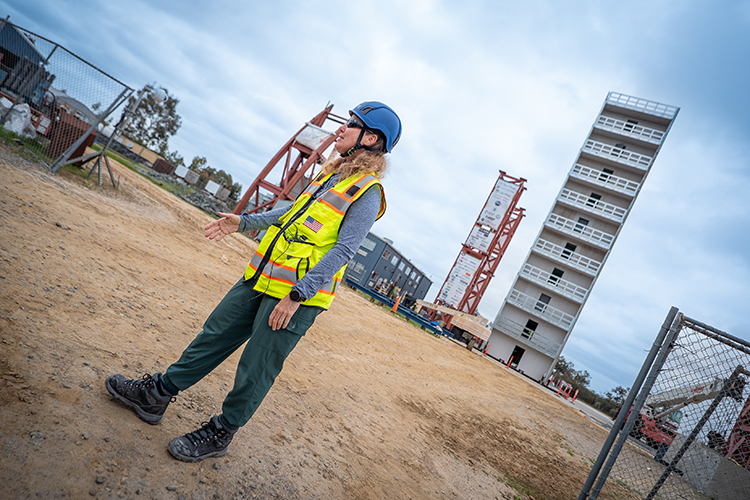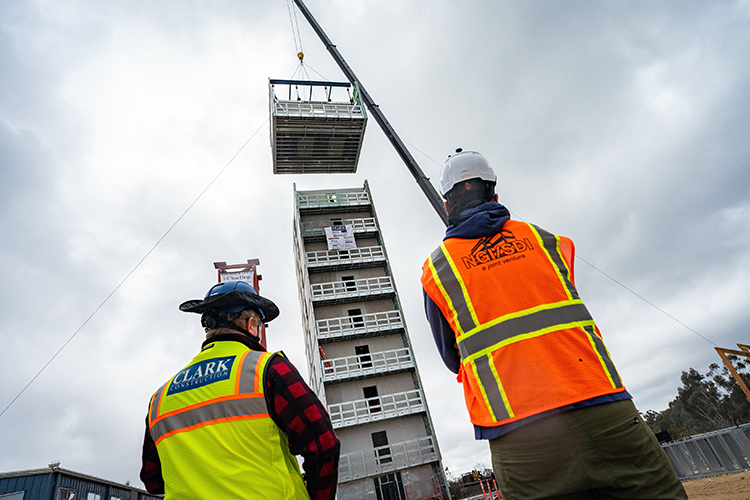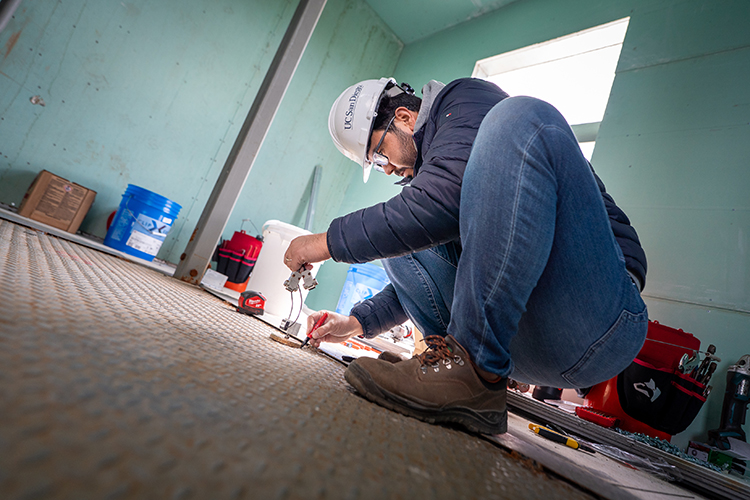10-story Steel-framed Building to be Put to the Test on UC San Diego Earthquake Simulator
Story by:
Published Date
Article Content
A 10-story cold-formed steel-framed building will soon be put to the test on an earthquake simulator at the University of California San Diego to see how well it can withstand earthquakes.
The UC San Diego shake table is the only outdoor facility of its kind in the world, and the only simulator capable of testing a building of this height.
Current building codes in the United States only allow for six-story buildings when cold-formed steel is the chosen structural system. The results of this test will help determine if that height limit can safely be increased. Researchers are planning to run the tests in June 2025.
The building is already constructed and is sitting on UC San Diego’s outdoor shake table. Researchers will turn the shake table on and recreate earthquake motions recorded during prior earthquakes, including recordings from the magnitude 6.7 Northridge earthquake which struck Los Angeles in 1994 and the magnitude 6.9 Loma Prieta earthquake which struck Northern California in 1989.
This outdoor earthquake simulator at UC San Diego can shake structures weighing up to 2,000 metric tons, or 4.5 million pounds—roughly the weight of 1,300 sedan-sized cars. This makes the earthquake simulator capable of carrying the heaviest test structures in the world. The shake table can also accelerate to at least 1g–the amount of gravity we experience on Earth when we fall. These motions can in turn accelerate the top of a 10-story building to as much as 3g. For reference, on average, riders on modern roller coasters experience 4g of peak acceleration. Because the shake table is outdoors, it is able to evaluate tall buildings that could not be tested elsewhere.
“We are able to test new ideas and push the boundaries of what we’re doing in structural design and construction,” said Tara Hutchinson, a professor in the UC San Diego Department of Structural Engineering and one of the project’s principal investigators. “Cold-formed steel is a great example of a promising light-weight, sustainable, and highly durable material, ideal for use in regions of high seismic hazard and for construction of tall buildings.”
The shake table is funded by the U.S. National Science Foundation, which is also one of the sponsors for this series of tests, dubbed CFS10, for cold-formed steel and 10 stories. It is part of NSF’s Natural Hazards Engineering Research Infrastructure network, or NHERI—eight experimental facilities supporting innovative research for mitigating damage caused by hazards such as earthquakes, tsunamis, landslides, wind storms, storm surge and flooding.
Cold-formed steel-framed building
The 10-story building’s skeleton is made from cold-formed sheets of construction-grade steel that are then shaped at room temperature to make individual structural components—studs and floor joists, for example. These are then fastened together to form walls and floors. Cold-formed steel is easy to manufacture, strong, light and made from recycled steel. The material has become more popular as a substitute for timber in the past four decades, partially because it can be shaped into components similar to those used in timber construction, such as two by fours. It also doesn’t burn when exposed to fire.

Photos: David Baillot/UC San Diego Jacobs School of Engineering
Currently, building codes in the United States only allow cold-formed steel-framed buildings up to 65 feet (20 meters), or about six stories tall. The research team from UC San Diego and Johns Hopkins University is evaluating how taller cold-formed steel-framed buildings, up to 100 feet (30 meters) or 10 stories, would fare during an earthquake.
“Through years of work, we’ve developed an understanding of how to model key components of new cold formed steel framing systems. We’ve used models and smaller-scale testing to determine if these systems can perform well in earthquakes, giving us confidence in our new solutions,” said Ben Schafer, a professor at Johns Hopkins University and the project’s other lead principal investigator. “Overall, if we can predict the precise performance of a new building system, we can share those predictions with engineers to improve building design and construction practices in the U.S.”
The building that will be tested in June is already constructed and sitting on the shake table. It was built using a variety of methods. The first level of the building is “stick-framed,” meaning it is assembled on-site with individual components—cold-formed steel track and studs in this case. Other floors are constructed of wall and floor panels: elements that have been pre-fabricated in a shop and shipped to the site. This project also explores how these panels can be put together into modules, similar to portable trailers, manufactured off site. These modules, very much like stacked Legos, are then assembled on site and lifted onto the building with a crane.
“These tests provide us a unique opportunity to document and compare the resilience of each construction method during an earthquake,” Hutchinson said.

Non-structural systems, fire tests and sensors
The building also includes what researchers call “non-structural” components, such as stairs, roof-top mechanical equipment and pressurized gas and fire sprinkler systems. The researchers will monitor the movement and accelerations in these elements to evaluate if the building would remain functional after a quake.
After the earthquake testing is over and all data has been gathered, the building will be put through a series of live fire tests to study how these components and the structure itself fare in a fire after an earthquake.
Researchers will gather data from earthquake and fire tests with thousands of sensors measuring everything from how much the building moves during a shake to the temperature distribution during fire tests.
“When we perform these large scale tests, it is important we capture response with high fidelity; in this case, we are using thousands of sensors, digital and analog, distributed throughout and around the building,” said Hutchinson. “That’s real data that allows us to explore and help improve design and construction methods, all of which will improve building codes.”
In addition to the NSF, the tests are sponsored by the U.S. Department of Housing and Urban Development, the California Seismic Safety Commission, the California Office of Emergency Services and the National Institute of Standards and Technology.
The tests also have garnered support from a significant number of industry organizations such as the American Iron and Steel Institute, the Steel Framing Industry Association and the American Institute of Steel Construction. Many companies have contributed to the design and construction effort, including ClarkDietrich, Clark Construction, Standard Drywall Inc., Mid-Rise Modular, Bapko Metal, Grabber Fastening and others. View a complete list of sponsors.

A critical shake table upgrade was completed in 2022, thanks to $17 million in NSF funding. The table is now able to reproduce the full 3D ground motions that occur during earthquakes, when the ground is moving in all six degrees of freedom—longitudinal, lateral, vertical, roll, pitch and yaw. This facility is part of the Englekirk Structural Engineering Center in the Department of Structural Engineering at the UC San Diego Jacobs School of Engineering.
The CFS10 tests are funded by NSF awards #1663569 and #1663348, as well as the aforementioned numerous sponsors and partners.
Share This:
You May Also Like
Engineers Take a Closer Look at How a Plant Virus Primes the Immune System to Fight Cancer
Technology & EngineeringStay in the Know
Keep up with all the latest from UC San Diego. Subscribe to the newsletter today.



